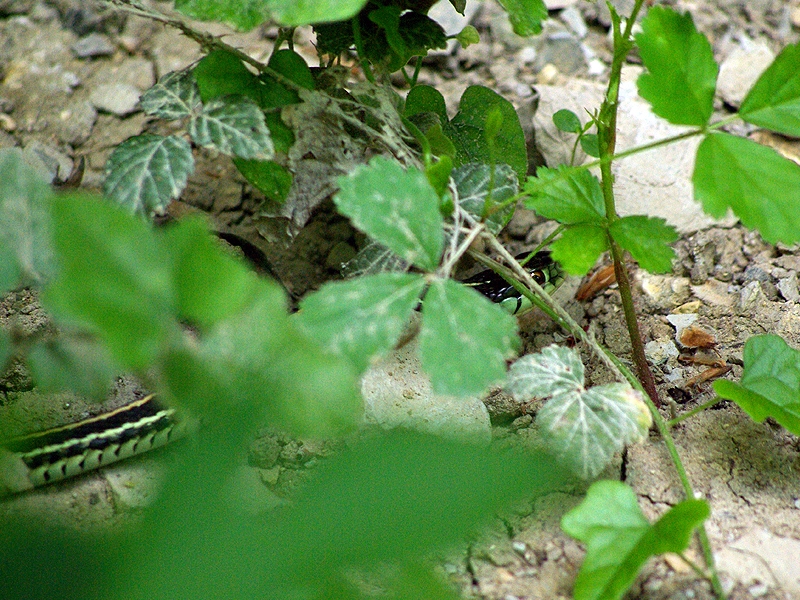I came across this Texas Garter Snake in the Lake Highlands area of Dallas, Texas. The snake was lying motionless in the dirt and gravel under an elevated DART rail.

I’ve seen many of these snakes in this area on previous visits, but never more than fleeting glimpses. They are always quick to flee when they detect someone approaching.

Because of this, I was puzzled when the snake did not try to retreat as I drew nearer. The snake’s head was covered by the leaves of a small bush, and maybe because of this the snake had the impression that he was more concealed than he actually was.
In any case, I could not see the condition of the snake’s head, and the though crossed my mind that maybe he was dead. I took a few picture and then attempted to prod the snake with my boot. Still no response from the reptile.
I began taking more pictures, working my way around the snake’s position. After traversing 180 degrees I could see the snake’s head. It looked OK. A closer examination of the body showed that the snake was breathing.





There was still no reaction from the snake even as I returned to my original position. I decided to gently prod the snake with a stick. That did the trick! The Texas Garter Snake coiled itself up into a defensive position in the blink of an eye.
Notice how the snake has flattened its body in order to appear larger. It has also flared it scales to reveal spots of light color that are not normally visible. Both behaviors are a natural part of the snake’s defensive response.








Chris,
Great photos. However, this is actually Thamnophis Sirtalis Annectens the Dallas subspecies of the Common Garter Snake. It is known as the ‘Texas Garter Snake’ and is actually relatively uncommon. Nice Find!
Thanks, Grant. I never felt confident about this ID. Can you share how you made the distinction?
Absolutely. I will spare the tiny details, but here are the tell tale signs in order of importance:
1. Behavior: The other local Thamnophis ( Western Ribbon Snake) is extremely fast. They are nearly impossible to photograph or catch because they disappear quickly into brush. The Texas Garter Snake tends to plod along and often even moves with a slow, jerky motion.
2. Labial Scales ( mouth scales): Chris, great job on the photo of the snakes head. You can see the black markings on the mouth scales. Clearly a Texas Garter. Western Ribbon Snakes do not have these black markings.
3. Coloration between dorsal stripe and lateral stripe: The Texas Garter Snake has splotches/checkers that can be seen while the Western Ribbon Snake is solid in color.
4. Stature: The Western Ribbon Snake has a more slender physique and a longer tail. The Texas Garter Snake is stockier and has a shorter tail.
Again, I must reiterate…great find! These are not nearly as common as one would suspect based on how common the species is in a large portion of its range.
I have only found these in two other Dallas County locales: Rowlett Creek/Ray Hubbard and the Spring Creek Forest Preserve ( Fred Harris).
This article was updated on Aug 3, 2012 to reflect that the snake in this observation is a Texas Garter Snake rather than a Western Ribbon Snake.
I saw one of these in my pasture this past week. I’m near Waxahachie. Your photos are beautiful. I did not have a phone or camera with me. The snake did not move quickly and coiled when I touched his tail. He was about two feet long. I did not know garter snakes could be stocky. Descriptions here are very helpful.